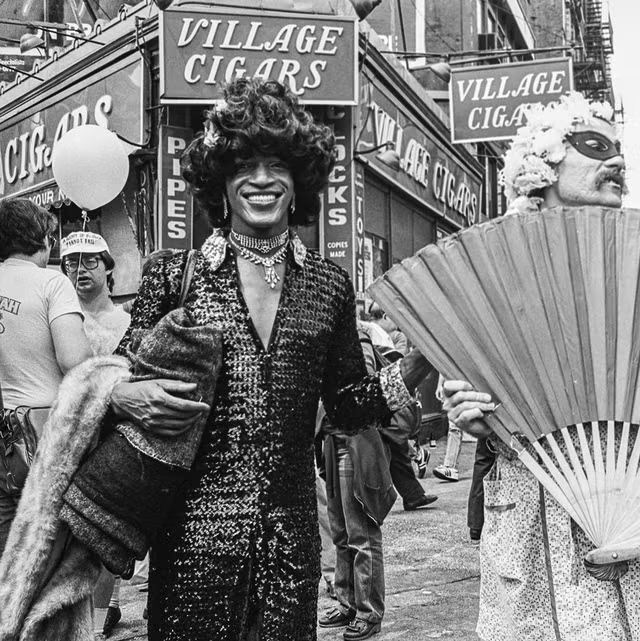On the Front Lines: Leather, Drag, and the Unapologetic Heart of Pride
- Chad White

- Jun 6
- 4 min read
Pride didn’t begin with a parade—it began with a riot. It began when queer people said “enough.” When police raided the Stonewall Inn in June 1969, it was drag queens, sex workers, trans women of color, street kids, and leathermen who pushed back. They lit the match, and we are still living in the fire of that rebellion.
The first Pride marches—then called Christopher Street Liberation Day—emerged from that uprising. But even then, pressure came from within the community to conform. Organizers in the 1970s urged marchers to wear suits, ties, and skirts—gender-normative, professional clothing meant to “present” the community as respectable and employable. This was a continuation of movements like those organized by the Mattachine Society, an early gay rights group, that had peacefully protested and picketed in the 1960s. It was an attempt to win the approval of the straight world by looking just like them.


But not everyone marched quietly
Groups like the Gay Liberation Front (GLF), Street Transvestite Action Revolutionaries (STAR), and ACT UP rejected the politics of respectability. They knew that liberation doesn’t come from fitting in—it comes from standing out. Drag queens who refused to be closeted, leathermen who refused to be ashamed, AIDS activists who lay down in the streets—they made the world listen.


Today, the tension between assimilation and radical visibility has reemerged in a new and troubling form: renewed calls to “clean up” Pride. These demands—to ban kink, to tone down expressions of queer sexuality, to make Pride more “appropriate”—are not simply questions of taste or decorum. They are strategic attempts to undermine and erase the most visible and defiant aspects of queer identity.
Much of this discourse originates in online spaces, where social media echo chambers have allowed a new generation of users—often younger or aligned with assimilationist ideals—to frame leather, kink, and drag as “inappropriate” or “unsafe for children.” This rhetoric, whether intentional or not, echoes the same moral panic that fueled anti-gay campaigns in the twentieth century. Simultaneously, respectability politics from within the queer community have resurged. Some LGBTQIA+ individuals, particularly those who have gained a degree of mainstream acceptance, now seek to distance themselves from drag performers, sex workers, and leatherfolk. In doing so, they attempt to secure broader social legitimacy at the expense of those whose visibility and risk made that legitimacy possible.
These internal debates are not occurring in isolation. Right-wing and conservative political actors have eagerly exploited them, amplifying anti-LGBTQ rhetoric under the guise of protecting children or preserving public decency. They weaponize images of kink and drag to support legislation banning Pride events or restricting queer expression, reviving old tropes of “grooming” and “deviance” to justify modern censorship. Their goal is not protection—it is erasure.
"We're all born naked and the rest is Drag."
- RuPaul Charles

Compounding these forces is the increasing commercialization of Pride. As parades and festivals grow more dependent on corporate sponsorship, organizers often feel pressured to
sanitize the event to remain “brand-safe.” This leads to a quiet but pervasive form of censorship, in which bold, subversive, or sexually expressive participants are discouraged or excluded—while companies with no meaningful commitment to LGBTQIA+ rights profit from rainbow marketing campaigns.

Together, these forces form a coordinated and deeply harmful effort to reshape Pride into something passive and palatable. But Pride was never meant to be sanitized. It was meant to be seen.
Let’s be absolutely clear: these efforts to sanitize Pride are not about inclusion. They are about erasure. They target the very people who have always stood on the front lines—drag queens, trans folks, leathermen, and kinksters—those who dared to be visible when visibility was dangerous.
We must not forget who led us. We must not abandon them now.
Whether you wear leather on occasion or live your life as a full-time leatherman—whether you take the stage in drag or stand cheering in the crowd—you are part of the legacy of resistance. You are one of the warriors of the LGBTQIA+ community. You are a brother, a sister, a sibling in arms.
Pride was never meant to be polite. It was always meant to be powerful.





















Well Said @Chad Foxhall !